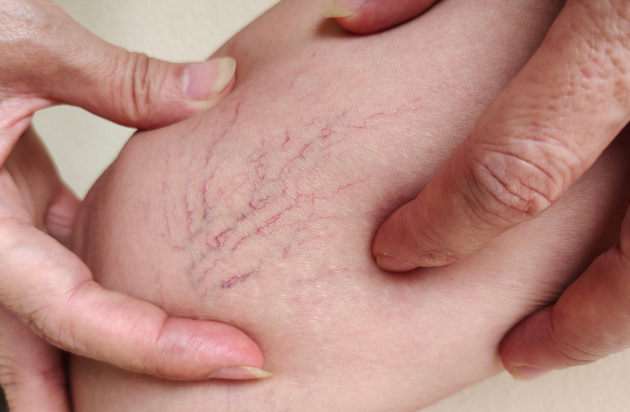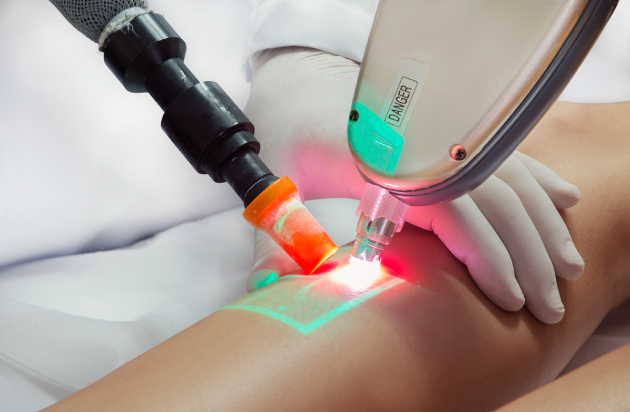Spider veins are tiny, blown-up veins appearing in web or thread-like clusters. They are usually red or purple and can appear anywhere on the body, though they’re most commonly found on the legs and face. While spider veins aren’t dangerous, many seek treatment due to their appearance. Here’s everything you need to to know about spider veins symptoms, causes, and treatment options.
Spider Veins Symptoms
Spider veins often have subtle symptoms that vary from person to person. Some may experience no discomfort, while others may notice mild to moderate symptoms. Common signs and symptoms of spider veins include:
Visible Veins: The most apparent symptom is small, web-like veins just beneath the skin’s surface, typically in shades of red, blue, or violet.
Itching or Burning Sensation: Some may experience itching or a mild burning sensation around the affected veins, adding a level of discomfort.
Aching or Heaviness: In certain cases, individuals may feel aching or heaviness in the legs, particularly after prolonged periods of standing or sitting.
Discomfort Worsened by Inactivity: The discomfort associated with spider veins is often exacerbated by extended periods of inactivity and may improve with movement.

Spider Veins Risk Factors
There are several causes of spider veins. It’s essential to know the risk factors to avoid getting the condition in the first place or stop new clusters from forming. Genetic predisposition to vein disorders makes you more likely to experience spider veins. Ageing is another significant risk factor, as the natural wear and tear on blood vessels over time can compromise their structural integrity. Gender also plays a role. Pregnancy and menopause result in hormonal fluctuations that can damage vein walls. Prolonged periods of standing or sitting, common in certain occupations, can impede blood circulation and increase the risk of blood pooling and overwhelming a vein over time. Other lifestyle factors, such as obesity and a sedentary lifestyle, can also contribute.
Spider Veins Treatment
We offer tailored treatments to ensure the best results. These include:
Sclerotherapy
This tried and true treatment for spider veins involves injecting sclerosant into the vein to seal it shut. Your body will absorb the vein in the coming weeks.
Nd:YAG
Transdermal laser works through the skin, making this option completely non-invasive. It’s great for small spider veins closer to the skin’s surface.
CLaCS
This novel method combines sclerotherapy and Nd:YAG with cryotherapy, allowing us to target more complicated vein clusters.

Frequently Asked Questions
Can Spider Veins Cause Serious Health Issues?
Spider veins are typically a cosmetic concern and don’t pose significant health risks. However, they can cause discomfort or aesthetic dissatisfaction.
Are Spider Veins Only a Cosmetic Issue?
Primarily, yes. However, spider veins can sometimes cause symptoms of itching and aches and be connected to an underlying issue like varicose veins.
Is There a Link Between Spider Veins and Varicose Veins?
While they share some similarities, spider veins and varicose veins are distinct. Spider veins are smaller and closer to the skin’s surface while varicose veins are larger and deeper. However, in some cases, a spider vein cluster may be connected to an underlying varicose vein.
Can Spider Veins Go Away on Their Own?
In some cases, spider veins can fade naturally. Usually, this happens if they pop up due to a risk factor like pregnancy, in which case the veins may go away a few months after you give birth once your hormone levels and blood volume return to normal. However, in many cases, you will need medical treatment to be rid of them.
Do Spider Veins Only Occur on the Legs?
No. Although they’re common on the legs, spider veins can appear anywhere on the body, including the face, arms, and torso.
Are Spider Veins Preventable?
Spider veins may not be 100% preventable, but there are steps you can take to reduce your risk. These include daily exercise, healthy eating, taking breaks between long hours of sitting or standing and protecting your skin from the sun.
Can Exercise Help Reduce Spider Veins?
Regular exercise promotes healthy blood circulation, which can reduce your risk of developing them. However, it will not make existing spider veins go away.
Do Spider Veins Always Get Worse Over Time?
Not necessarily. The progression of spider veins varies among individuals. Some may remain stable, while others may slowly worsen over time.
Can Spider Veins Impact Pregnancy?
It’s highly unlikely that spider veins will affect your pregnancy. However, pregnancy can cause new clusters to form and may worsen existing ones.
